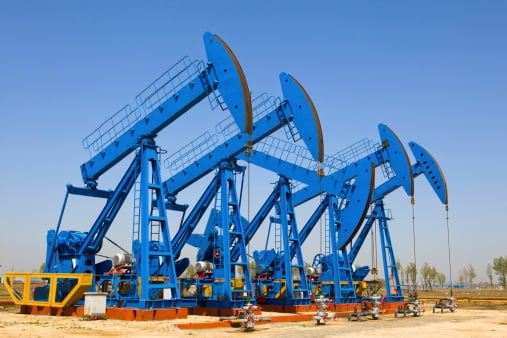When the U.S. housing market fell apart and the financial crisis threatened to toss a wrench into the global economy, there were pockets of relative plenty. In the United States, one of those was North Dakota, where crude oil production was about to hit high gear as horizontal drilling and hydraulic fracturing came to dominate drilling techniques in the Bakken shale play. Source: Thinkstock
Source: Thinkstock
Just over 21% of North Dakota’s total 2013 gross domestic product (GDP) of $49.77 billion comes from natural resources and mining. Not all the $10.6 billion in natural resources and mining is due to oil and gas extraction, but that is as granular as the federal data allows.
In 2013, the average spot price of a barrel of West Texas Intermediate (WTI) crude oil was $97.91, according to the U.S. Energy Information Administration (EIA). The EIA is currently estimating a per barrel price of $95 for WTI in 2014. That estimate does not yet include the big price drop in November. And the current EIA estimate for a barrel of WTI in 2015 is $77.75.
Bakken crude oil from North Dakota is priced at a discount to WTI crude, and in 2013 that discount likely averaged between $7 and $10 a barrel. In mid-November this year the discount was $8 a barrel at the pricing point in Clearbrook, Minn.
ALSO READ: 8 States Where Gas Will Drop Below $2
Applying a discount for Bakken crude of $8 a barrel to the 2013 WTI price yields a per barrel price for Bakken crude in 2013 of around $90 a barrel.
WTI for January delivery trades on Tuesday at around $68 a barrel. Applying the Bakken crude discount, that indicates a price of $60 a barrel for January delivery.
At the roughest approximation, and smoothing the numbers out, the drop to $60 a barrel could cost North Dakota somewhere around $3.5 billion in GDP over the course of a year, if there is no price recovery. Unfortunately, reaching the point of being able to get to a closer number will only be possible once we know what sort of time oil prices remain low and what sort of discount to WTI holds up through time. Then there is trying to factor in which projects may simply go idle or be ratcheted down and delayed.
If the discounted price of Bakken crude remains around $60 a barrel, some producers may be forced to sell assets, and some may even close up shop. But the oil will remain in the ground and that is important to the state of North Dakota.
The state levies a 5% production tax on the gross value at the wellhead of all oil produced in the state, with some exceptions. The state also levies an oil extraction (excise) tax on produced oil. In 2012 the state collected $1.68 billion in oil revenues, up 71.4% over its 2011 collections. Oil taxes provide 42.3% of the state’s total net revenues, nearly four times the individual income tax and more than eight times the revenue received from corporate income taxes.
The state’s 5% oil production tax is split between state and county governments. The state treasurer takes 20% that it then allocates to cities and to an impact grant program. The remaining 80% is split between the state and county governments according to a mandated formula.
ALSO READ: Could Exxon and Chevron Be the Top-Performing Dow Stocks of 2015?
The oil extraction tax rate is 6.5%, but that can be reduced to 4% under certain circumstances or to 2% under certain other circumstances. Most of the incentives that would lower the extraction tax rate are triggered by oil prices. The current trigger price is $52.50 a barrel. When the wellhead price is above that level, the producer pays the full tax rate. When the price falls below that trigger rate, the incentives kick in and tax revenues will necessarily decline.
North Dakota runs its state budget on a two-year, or biennium, method. In the current biennium, 2013 to 2015, the state is budgeting for total revenues of about $4.6 billion. Oil and gas production taxes are expected to provide the state’s general fund with $133.84 million for the biennium and the oil extraction tax is expected to provide $166.16 million. Combined that is about 4.3% of the biennium budget.
The state created a legacy fund in 2010 — similar to a sovereign wealth fund in foreign nations — to salt away some of the state’s revenues from oil and gas production. By law, 30% of the state’s oil and gas taxes (after some mandated distributions) are deposited in the legacy fund. This has resulted in oil and gas tax collections of $446.3 million for fiscal year 2012, $824.7 million for fiscal year 2013 and $926.6 million for fiscal year 2014.
The state’s own budget does not depend heavily on oil and gas taxes, but low prices should seemingly have a more serious impact on the cities and counties located within and surrounding the Bakken play that have seen so much of this shale boom. For example, the first $2 million of the gas production tax collected by a county stays in the county. The next million is split 75%-25% with the state, and the next million is split evenly. After that the state takes 75% up to $18 million in collections and 100% of everything above $18 million.
A drop of a third in the wellhead price of oil could cost the state more than $300 million in annual contributions to its legacy fund and some portion of the $300 million that production taxes now contribute to the state’s general fund. The impact on cities and counties is almost guaranteed to be more damaging.
ALSO READ: Analysts Pick MLPs Insulated From Low Oil Prices
Sponsored: Find a Qualified Financial Advisor
Finding a qualified financial advisor doesn’t have to be hard. SmartAsset’s free tool matches you with up to 3 fiduciary financial advisors in your area in 5 minutes. Each advisor has been vetted by SmartAsset and is held to a fiduciary standard to act in your best interests. If you’re ready to be matched with local advisors that can help you achieve your financial goals, get started now.
Thank you for reading! Have some feedback for us?
Contact the 24/7 Wall St. editorial team.



